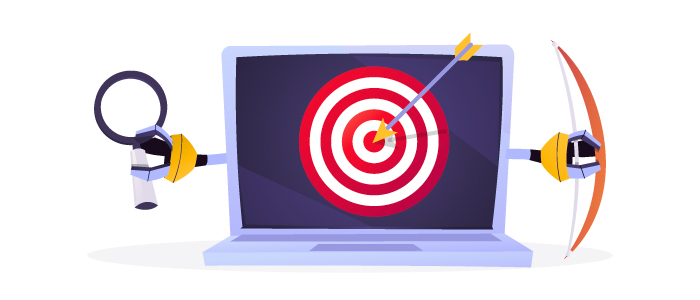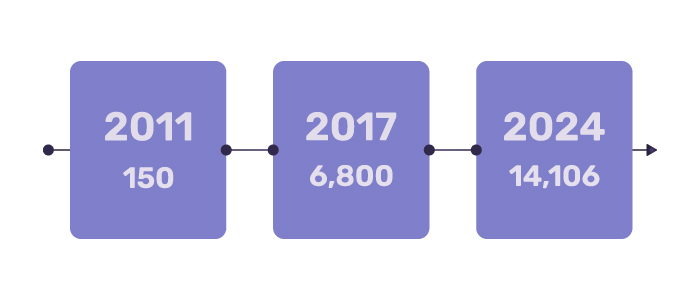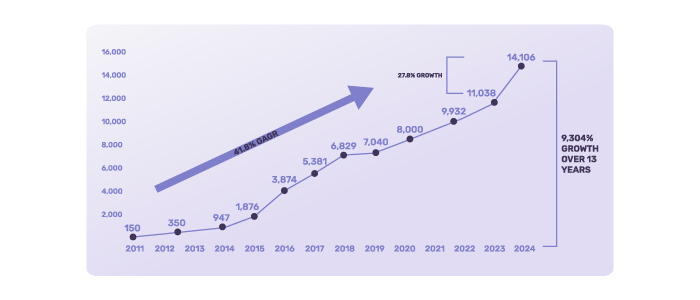Your Guide on the MarTech Ecosystem & How It Can Help You
You probably often look at your competition and notice they’re doing better in certain areas, right? Maybe they have a stronger content team or a more effective social media strategy.
But that’s not all. You can outdo them using tools that make your business run smoother and more efficiently. How? By tapping into the MarTech ecosystem.
But what exactly is the MarTech ecosystem, and how can you use it for better results?
In this article, we will explain the MarTech ecosystem and guide you on how to use it to your advantage. From understanding its parts to building an effective MarTech stack, we’ll show you how to use these tools to boost your marketing performance and outperform your competition.
Let’s get started!
Table of Contents
What Is The MarTech Ecosystem?

The MarTech ecosystem includes the entire market of tools, platforms, and technology businesses or marketers use to build, manage, automate, run, optimize, and measure their marketing efforts.
However, to get back to basics, check out our Marketing vs. Advertising guide for a better perspective.
How Big Is the Market of the MarTech Ecosystem?
To understand the size of the MarTech market, let’s look at Scott Brinker’s 2024 Marketing Technology Landscape report. This report is the most trusted source for assessing how fast MarTech grows.
The writing of this report began in 2011 when the first report listed only 150 marketing technology solutions. This was a big deal at the time, showing how technology was starting to play a key role in marketing. Now, 13 years later, the MarTech landscape has grown every year.

The 2024 report shows that there are now more than 14,106 marketing technology products. Last year, there were 11,038 products, which means over 3,000 new solutions were added in just one year. This is a huge 27.8% growth in just 12 months.

This fast growth shows how much innovation is happening in the industry.
New tools and platforms are constantly being created to meet the needs of businesses and marketers. From data analytics and customer relationship management to content creation and social media management, the MarTech ecosystem has many technologies to improve every part of marketing.
Regarding the industry’s monetary value, according to Statista, the global marketing technology market grew by over 31% in 2023 compared to the previous year. The market’s value increased from $508.9 billion in 2022 to nearly $670 billion in 2023.
At the time of writing, we don’t have estimated figures for 2024. However, with the increase in MarTech platforms, we expect the industry’s value also to rise.
7 Types of MarTech Ecosystem Platforms
As we mentioned and as the top image in the report shows, the MarTech ecosystem is vast, with many different platforms that simplify marketers’ lives. Given the variety, we can’t cover all of them, but we’ll highlight the most used and popular MarTech platforms.
In a nutshell, they are:
- Customer-Relationship Management (CRM) Platforms;
- Customer Data Platforms;
- Marketing Automation Platforms;
- Social Media Management Platforms;
- Personalization Platforms;
- Content Creation and Optimization Platforms;
- Analytics and Testing Platforms.
MarTech Ecosystem vs. MarTech Stack – What’s the Difference?
Do not confuse a MarTech stack with the MarTech ecosystem. We say this because we often notice that these terms are used interchangeably, and the reality is that it’s not quite correct, as the MarTech ecosystem and MarTech stack represent different aspects of the marketing technology landscape.

A marketing stack is the set of online tools and software that a marketing team uses for its tasks. When marketers talk about their stack, they usually refer to the tools they use daily.
In contrast, the marketing ecosystem includes all the tools, platforms, and technologies available for different purposes. It covers everything businesses and marketers use to create, manage, automate, and measure their marketing efforts.
A marketing stack is just a part of the larger marketing ecosystem. While the ecosystem represents the whole range of available tools, the stack is about the specific tools a particular business uses.
Leverage the MarTech Ecosystem for Better Results
Now that you know the basic information about the MarTech ecosystem, it’s crucial to understand that leveraging it can effectively and significantly enhance your marketing efforts, leading to better engagement, conversion, and ROI results.
We also know that the MarTech landscape is vast, and navigating this ecosystem can be challenging without a clear strategy. So, here are some ideas to help you:
1. Define Clear Marketing Objectives
Before anything else, start by setting clear marketing objectives. Without proper goals, everything else amounts to zero. So, define what you want to achieve.
Picture venturing on a trip without knowing where you’re headed; that’s what marketing without clear objectives feels like.
Begin by identifying your main goals. Do you want to increase sales, boost brand awareness, or improve customer retention? Each of these goals requires a different approach and set of tools, so it’s essential to be specific.
For example, if your goal is to increase sales, detail the specific targets, like a percentage increase in revenue or the number of new customers you aim to acquire within a specific period. This clarity helps you choose the right MarTech tools, such as CRM platforms to manage leads or marketing automation tools to nurture potential customers through the sales funnel.
Next, ensure these marketing objectives align with your overall business goals. Your marketing efforts should not operate in isolation; they must support the company’s broader strategy.
For instance, if your business aims to expand into a new market, your marketing goals should include actions that support this expansion, such as increasing brand visibility in the new region or tailoring campaigns to local preferences. This alignment ensures that your marketing activities help drive the business forward cohesively and strategically.
2. Conduct a MarTech Audit
Conducting a MarTech audit is essential before fully utilizing the MarTech ecosystem. This involves examining the tools you currently use and evaluating their effectiveness.
So, begin by assessing your existing MarTech stack. Examine how well each tool supports your marketing efforts and whether it aligns with your goals. Are the tools helping you achieve your objectives, or are there areas where they fall short?
Also, identify gaps in your MarTech stack and determine which aspects of your marketing strategy could benefit from additional tools or improvements.
For instance, you might find that while your social media management tool is effective, your customer relationship management (CRM) system lacks the features you need for detailed customer insights. Recognizing these gaps helps you understand where your current tools are lacking and what new solutions might be necessary.
Once you’ve identified the gaps, prioritize your needs. Focus on tools that directly address your marketing objectives.
If your primary goal is to enhance customer engagement, prioritize tools that offer strong analytics and personalized marketing capabilities. By concentrating on what matters most to your goals, you can make informed decisions about which new tools to integrate into your MarTech stack.
3. Create Your MarTech Stack
Building a good MarTech stack is the next important step. Since you have already audited your martech stack (if you had one), you can now choose tools that complement each other and seamlessly integrate to share data. Of course, all of these platforms must follow your objectives.
Choosing platforms with multiple integration possibilities is a must. For example, a good platform isn’t enough if it can’t interact with the rest of your MarTech stack. This integration confirms that information flows smoothly between platforms, providing a unified view of your marketing activities.
For instance, your email marketing tool should easily integrate with your CRM system to track customer interactions across channels.
So, prioritize data unification by ensuring all customer data is accessible in one centralized location. A unified data approach allows for more accurate insights and better decision-making. It helps you understand your customers better and personalize your marketing efforts more effectively.
Next, be sure that you understand your audience’s needs. Knowing your target market inside and out is crucial. Different tools offer varying levels of customer insights, so it’s vital to choose ones that help you better understand your audience’s behavior, preferences, and pain points.
Further, focus on user-friendly interfaces. The tools you select should be easy for your team to use. Complicated or unintuitive interfaces can slow down productivity and hinder adoption. Look for platforms that offer a smooth user experience with clear dashboards and intuitive navigation.
Also, consider scalability when selecting tools. Choose platforms that can grow with your business. As your company expands, your marketing needs will evolve, and your MarTech stack should be able to accommodate this growth. Opt for flexible tools that adapt to new challenges and opportunities, ensuring long-term success.
There are many aspects to consider when creating a good MarTech stack, but applying at least the ones mentioned here significantly improves your chances of success.
If your MarTech stack isn’t performing as well as you’d hoped, remember that…
4. Optimization is an Ongoing Process
Continuously assess and refine your tools and strategies to meet your evolving needs and objectives.
Optimization is key to maintaining an effective MarTech stack. Regularly assess performance by monitoring key metrics to measure the impact of your MarTech tools. This involves tracking important indicators such as customer engagement, conversion rates, and ROI to understand how well your tools are performing. If you identify any areas lacking, take proactive steps to address them.
Stay agile and adapt to changes as they arise. The digital marketing landscape constantly evolves, so it’s important to be flexible and ready to adjust your strategy when needed. This could mean integrating new tools, updating existing ones, or changing your approach based on the latest trends and technologies.
Optimize efficiency by simplifying processes and eliminating redundancies. Ensure that your MarTech stack is effective and efficient regarding time and resources.
Look for opportunities to automate repetitive tasks, simplify workflows, and reduce tool overlap. This will help you maximize the return on your MarTech investments and maintain a lean, powerful marketing operation.
Closing Line
The MarTech world is growing, offering many opportunities to enhance your marketing results. By understanding the MarTech ecosystem and learning how to leverage it, you can boost your marketing performance, engage better with your audience, and achieve a higher return on your investment.
Keep in mind, though, that marketing technology is vital and great, but it is just one part of the bigger picture when it comes to crafting successful online campaigns.